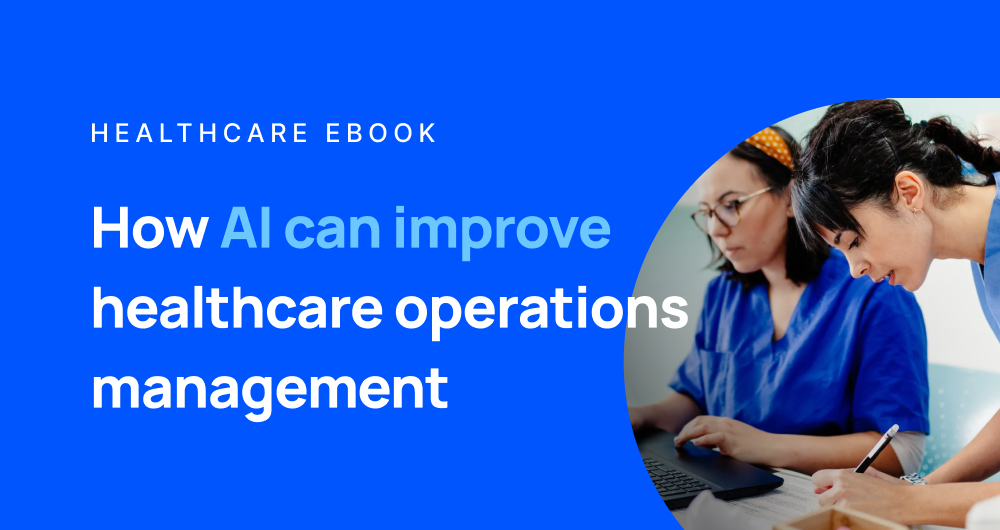6 Strategies to improve employee engagement in healthcare
The healthcare industry is rapidly changing as organizations strive to remain competitive and profitable in the wake of the COVID-19 pandemic. Many companies have adopted new tools, processes, and strategies to better deliver patient care when and where it’s needed; but in the rush to meet demand, efforts to ensure high levels of employee engagement have fallen by the wayside.
The result is an increase in stress and burnout in the medical workplace, with healthcare workers struggling to keep up with rising expectations while receiving inadequate support from their employers.
Competitive healthcare companies know that theirs is an industry in which high employee engagement is absolutely critical to their success, and that low engagement can result in high turnover rates, decreased patient care, and even legal repercussions.
Here, we’ll discuss six healthy workplace strategies that organizations can implement to boost employee engagement and—in turn—increase patient satisfaction, worker productivity, performance, and revenue.
What is Employee Engagement?
Employee engagement refers to the connectedness a worker feels with the place in which they work and its components, like their manager, supervisor, team members, role, company culture, and the business as a whole. In the context of healthcare, employee engagement can also include how workers perceive and relate to patients, how they’re expected and empowered to deliver care, and how their efforts are recognized.
Higher levels of engagement are linked to employees who are more dedicated, enthusiastic about, and focused on their work. Increased morale among even one employee can spread to their coworkers and make for a more positive work environment. By increasing their teams’ engagement, organizations can see an uptick in revenue, too, as those with high employee engagement levels show 21% greater profitability than their disengaged counterparts.
Disengaged employees, on the other hand, may spread negativity and be at a greater risk for absenteeism and turnover. This is particularly concerning in areas like home healthcare, where turnover rates reached 22.18% in 2020. As staffing shortages continue to plague the healthcare industry as a whole, healthcare providers now have the advantage when assessing potential employers; so organizations should indeed prioritize engagement strategies that promise retention and attract new talent, too.
Fully engaged healthcare workers deliver higher quality patient care, too. Patients receive greater sense of support, empathy, and empowerment when their healthcare provider is excited by and accountable for their work, and are thus more likely to continue their relationship with that provider. It’s a chain reaction, wherein engaged employees facilitate better patient engagement among their clients, and those patients feel satisfied by the care that they receive.
Plus, higher engagement means increased safety, fewer malpractice claims, and greater overall revenue. One study of 200 hospitals found that nurse engagement is the number one predictor in mortality variation across hospitals—a number that even exceeds the outcomes of inefficient staffing. Another report directly ties together the relationship between higher employee engagement levels and lower hospital acquired conditions (HACs), readmission rates, reporting delays for insurance claims, and the overall cost of insurance claims.
6 Strategies to Improve Employee Engagement in Healthcare
A recent survey showed that 93% of healthcare workers are experiencing stress, and 76% felt exhausted and burnt out. With digital transformation initiatives and ever-evolving compliance requirements a primary focus for organizations, employee experience is often deprioritized.
But in order to retain their talent, deliver consistently exceptional patient care, and maintain profitability, healthcare companies must implement sophisticated strategies that drive employee engagement.
Here are six key strategies that your healthcare organization should prioritize for a more engaged workforce:
1. Improve communication across departments
Communication across a healthcare organization is absolutely vital to both employee engagement and patient outcomes; but it’s often also an enormous challenge, particularly for those that have a mobile or blended workforce. Communication tools are typically disjointed, with different teams (or even individuals) using multiple tools to send and receive updates, request assistance, or access patient information.
If your healthcare workers are using phone calls, emails, text messages, Slack, and other tools to communicate with each other and their patients, they’re likely wasting precious time—and risking miscommunications that could lead to serious consequences for patients and the business alike. It’s stressful, frustrating, and time-consuming for already-busy healthcare providers, and can make them feel disconnected from their work.
With the right technology, healthcare workers are always connected to each other and administrators, supervisors, and patients—regardless of where they are. User-friendly communication apps enable effective, real-time communication in a single place, so healthcare employees always have a finger on the pulse of what’s happening with patients, colleagues, and the overall company. This helps them complete their work as seamlessly as possible and focus on what truly keeps them engaged: delivering superior care to their patients.
2. Encourage a culture of accountability
44% of employees say they’d switch jobs if they didn’t receive adequate recognition for their work. At the same time, one study showed that 82% of leaders admit that they have “limited to no ability” to hold employees accountable for their work. While recognition and accountability are closely linked, ensuring both requires complete transparency into what healthcare providers are doing, where they are, what they’re supposed to do next, and what they’ve already completed; a colossal challenge for organizations with a dynamic team of providers.
Home healthcare companies especially struggle to gain the transparency required for a truly accountable work culture, as their employees deliver care outside of a traditional hospital or clinical setting. Regardless of how and where an organization’s providers care for patients, keeping track of each individual employee’s locations, appointments, and progress (along with patient details and other essential data) is a complex feat—and one that shouldn’t be ignored if they want to engage their employees, provide sufficient recognition for their work, and even verify adequate and timely delivery of care.
To build a culture of accountability, your team needs tools to back them up. Robust software solutions offer automated invoicing, seamless incident management, and complete workforce visibility in a single, centralized place. They track the location and progress of employees in real time, provide appointment status updates, and notify team members of changes as they happen.
Providers can remain productive and engaged as they complete their work, and they know that their efforts are documented with accuracy. Managers and supervisors rest easy knowing their employees are delivering the right care at the right time and place, and that they can intervene swiftly and appropriately if an individual’s performance starts to slip. They can also offer recognition, gratitude, and rewards to providers who consistently knock it out of the park, which in turn motivates team members.
3. Use AI Scheduling
Many healthcare companies still rely on manual processes or outdated tools (like whiteboards, emails, spreadsheets, and online calendars) to schedule patient appointments. It’s a tedious, time-intensive process that invites human error into the equation.
Administrators must match the right patient to the right provider (based on qualifications, certifications, skills sets, location, availability, patient history, etc.), then often re-enter that data into a separate system of record. Throw in a last-minute cancellation, sick employee, or no-show and the whole process begins again: Find a qualified, available provider, contact them for appointment acceptance, verify with the patient, and hope that nothing changes.
As the healthcare company grows and business objectives change, this manual process becomes even more burdensome. Healthcare providers and administrators alike feel the pressure to create efficient schedules, pair the right worker with the right patient, ensure care delivery to as many patients as possible, and rush to accommodate scheduling changes as they occur. It leaves much to be desired in terms of engagement, satisfaction, and overall fulfilment in one’s work.
But with AI-powered automated scheduling tools, healthcare companies can reduce scheduling frustrations without sacrificing worker productivity and efficiency. These technologies instantly generate the best schedules for healthcare teams, based on the myriad pieces that make up the larger operational puzzle. They take into account employee information, patient details and history, and broader business objectives to ensure schedules that maximize workers’ time.
Administrators are freed up to focus on other essential tasks, while healthcare providers always have real-time access to fully optimized schedules. Since automated scheduling tools instantly update as changes occur, providers never waste time traveling to a canceled appointment. Plus, they can accept new appointments in the face of a last-minute cancellation, which reduces idle time and keeps them engaged in their daily work.
4. Allow easy access to reports and analytics
Reliable, robust healthcare data is vital to understanding workforce operations, delivering better patient care, improving the revenue cycle, and—you guessed it—improving employee engagement. But as compliance regulations continue to change and healthcare companies seek to avoid data breaches, many have shied away from taking full advantage of the benefits data promises.
If your healthcare organization isn’t yet leveraging advanced analytics and reporting to glean accurate operational insights and drive meaningful improvements across processes, workflows, and care delivery, it might be time to take the plunge. There are, of course, some best practices that should absolutely be followed to maintain security and ensure compliance; but just as important is the data you collect, how you collect it, and how you use it, too.
For mobile and home health workers, for instance, seamless field data collection is crucial for continuity of care. Enable your healthcare providers with mobile-friendly, secure tools that allow them to collect patient and appointment information, client preferences, signatures, feedback, incidents, and more in a single place. That way, they don’t have to waste time and energy jotting down information on paper, transporting it back to HQ, then re-entering it into a system of record (which is a risky process in its own right). When they can instantly capture these details in an easy-to-use app, they aren’t distracted during patient appointments, and can completely focus on and remain engaged in their work.
Over time, data captured in the field and through other various sources (e.g. EHR system, finance software, HR and payroll tools, etc.) can be analyzed by robust technology that generates easy-to-read reports. Some data analytics tools allow relevant users instant access to those reports, so everyone is always on the same page about progress, performance, shortcomings, and opportunities for growth. When your organization is transparent about data, why it’s collected, how it’s used, and what it means, everyone can work toward a common goal of improving operations and outcomes. The result is a workforce that’s totally engaged in how they contribute to the business’s success.
5. Match patients with preferred caregivers
When creating schedules, matching patients with their preferred caregivers often gets pushed in favor of more obvious concerns, such as qualifications, skill sets, and availability. This is often the case for healthcare organizations that lack the proper tools for visibility into clinical needs, patient and employee preferences, and other key scheduling factors; as well as for those that haven’t yet automated the scheduling process.
By prioritizing and improving transparency across your healthcare operations, you can gain a comprehensive picture of patient data, history, and preferences. Staff schedulers can instantly match patients with preferred caregivers (like those who speak their native languages, have cared for them before, or have been referred to them by a friend) when they have uninhibited, real-time access to details for consideration. Automated scheduling tools help here, too, since they generate schedules based on pre-established preferences and constraints.
Patients are more likely to take an active role in their care if they have positive experiences with their caregivers. When they trust their caregivers to make the best decisions for their health, they’re less likely to cancel appointments, require several visits to resolve issues, or switch to another care provider. By the same token, caregivers feel a sense of fulfilment and achievement in their work when their patients demonstrate engagement and satisfaction.
6. Prioritize mental health resources
The harsh reality for many caregivers is that their demanding schedules and dedication to their work force them to prioritize the health of their patients far before their own. Many healthcare organizations fail to implement programs or offer resources to help ensure the wellbeing of their employees, but the high-stress nature of medical work can have a number of negative effects on workers. Among them is an inability to work productively and a higher risk of absenteeism, which adversely impacts operations, patient satisfaction and outcomes, and turnover and retention rates.
If a healthcare company is serious about employee engagement and the benefits it has to offer, then it should also make a genuine commitment to the mental health of its workforce. Organizations can create healthier work environments by:
- Creating and sharing scheduling (and any subsequent updates) in a consistent, timely manner
- Building a culture, policies, and schedules that help employees gain a healthy work-life balance
- Communicating with employees about the mental health resources that are available to them, including HR team members, relevant literature, community support groups, and more
- Offering career development and training opportunities on a consistent basis
- Fairly measuring, recognizing, and rewarding workers’ contributions and achievements.
By illustrating that your company cares about more than its employees’ performance, you’ll find it easier to connect with and engage with workers on a deeper level. In turn, workers will remain loyal to your company and find joy and fulfilment in representing your brand in the best light possible.
Intelligent Tools for a More Engaged Healthcare Workforce
As The Great Resignation marches on, healthcare organizations must find ways to retain their current employees and attract new talent moving forward—or risk high turnover, poor patient satisfaction, and lost revenue. Strong strategies (backed by powerful technologies) can help your company eliminate the barriers to effective employee engagement for a happier, more productive team.
Skedulo’s automated scheduling solutions arm healthcare organizations with everything they need to make their employees’ work as frictionless as possible. With tools for seamless communication, intelligent job matching, powerful analytics and reporting, mobile data collection, and more, Skedulo can help your company boost employee productivity, engagement, and success; which in turn leads to better quality patient care.
Learn more about how to empower your healthcare providers to succeed, or book a demo today.




